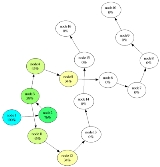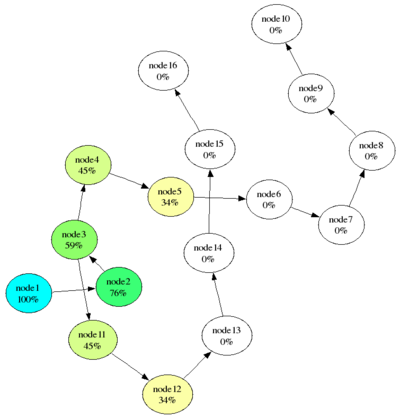
Spreading activation
Encyclopedia
Spreading activation is a method for searching associative networks, neural network
s, or semantic network
s. The search process is initiated by labeling a set of source nodes (e.g. concepts in a semantic network) with weights or "activation" and then iteratively propagating or "spreading" that activation out to other nodes linked to the source nodes. Most often these "weights" are real values that decay as activation propagates through the network. When the weights are discrete this process is often referred to as marker passing. Activation may originate from alternate paths, identified by distinct markers, and terminate when two alternate paths reach the same node.
Spreading activation models are used in cognitive psychology
to model the fan out effect.
Spreading activation can also be applied in information retrieval
, by means of a network of nodes representing documents and terms contained in those documents.
Parameters:
Steps:

Neural network
The term neural network was traditionally used to refer to a network or circuit of biological neurons. The modern usage of the term often refers to artificial neural networks, which are composed of artificial neurons or nodes...
s, or semantic network
Semantic network
A semantic network is a network which represents semantic relations among concepts. This is often used as a form of knowledge representation. It is a directed or undirected graph consisting of vertices, which represent concepts, and edges.- History :...
s. The search process is initiated by labeling a set of source nodes (e.g. concepts in a semantic network) with weights or "activation" and then iteratively propagating or "spreading" that activation out to other nodes linked to the source nodes. Most often these "weights" are real values that decay as activation propagates through the network. When the weights are discrete this process is often referred to as marker passing. Activation may originate from alternate paths, identified by distinct markers, and terminate when two alternate paths reach the same node.
Spreading activation models are used in cognitive psychology
Cognitive psychology
Cognitive psychology is a subdiscipline of psychology exploring internal mental processes.It is the study of how people perceive, remember, think, speak, and solve problems.Cognitive psychology differs from previous psychological approaches in two key ways....
to model the fan out effect.
Spreading activation can also be applied in information retrieval
Information retrieval
Information retrieval is the area of study concerned with searching for documents, for information within documents, and for metadata about documents, as well as that of searching structured storage, relational databases, and the World Wide Web...
, by means of a network of nodes representing documents and terms contained in those documents.
Algorithm
A directed graph is populated by Nodes[ 1...N ] each having an associated activation value A [ i ] which is a real number in the range [ 0.0 ... 1.0]. A Link[ i, j ] connects source node[ i ] with target node[ j ]. Each link has an associated weight W [ i, j ] usually a real number in the range [0.0 ... 1.0].Parameters:
- Firing threshold F, a real number in the range [0.0 ... 1.0]
- Decay factor D, a real number in the range [0.0 ... 1.0]
Steps:
- Initialize the graph setting all activation values A [ i ] to zero. Set one or more origin nodes to an initial activation value greater than the firing threshold F. A typical initial value is 1.0.
- For each unfired node [ i ] in the graph having an activation value A [ i ] greater than the node firing threshold F:
- For each Link [ i , j ] connecting the source node [ i ] with target node [ j ], adjust A [ j ] = A [ j ] + (A [ i ] * W [ i, j ] * D) where D is the decay factor.
- If a target node receives an adjustment to its activation value so that it would exceed 1.0, then set its new activation value to 1.0. Likewise maintain 0.0 as a lower bound on the target node's activation value should it receive an adjustment to below 0.0.
- Once a node has fired it may not fire again, although variations of the basic algorithm permit repeated firings and loops through the graph.
- Nodes receiving a new activation value that exceeds the firing threshold F are marked for firing on the next spreading activation cycle.
- If activation originates from more than one node, a variation of the algorithm permits marker passing to distinguish the paths by which activation is spread over the graph
- The procedure terminates when either there are no more nodes to fire or in the case of marker passing from multiple origins, when a node is reached from more than one path. Variations of the algorithm that permit repeated node firings and activation loops in the graph, terminate after a steady activation state, with respect to some delta, is reached, or when a maximum number of iterations is exceeded.
Examples


